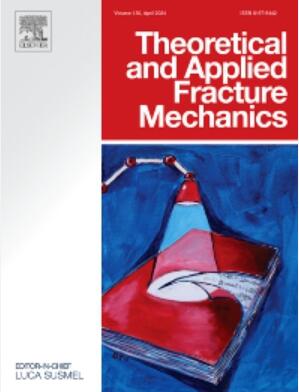Non-Proportional mixed mode plastic zones via finite elements and artificial neural networks
IF 5
2区 工程技术
Q1 ENGINEERING, MECHANICAL
引用次数: 0
Abstract
The plastic zone developed around a fatigue crack tip can affect both fatigue and fracture material behaviour. Predicting the plastic zone shape and size under cyclic conditions can, therefore, enhance fatigue crack propagation analysis. While there are theoretical solutions for the elastic stress and strain fields under pure or mixed mode conditions around the crack tip, solutions for plastic fields must be determined using experimental or numerical approaches. The Compact Tension Shear (CTS) specimen has been extensively used to analyse plastic zones under proportional conditions, but when non-proportional conditions are applied the number of necessary analyses for a reasonable understanding of the plastic zone shape and size around the crack tip can increase exponentially. To address this problem, a combined approach was used to reduce the number of required plastic zone simulations. First, a hand selected number of loading configurations were simulated using the Finite Element Method (FEM), predicting the plastic zone shape and size. Then, an Artificial Neural Network (ANN) was trained to predict the plastic zone under different conditions. Using only 18 configurations for 3 different loading conditions, the trained ANN was able to accurately predict the plastic zone shape and size for both tensile and shear propagation modes. The network can now be used to predict the plastic zone influence on fatigue and fracture behaviour, without the need for further numerical analysis. The paper results also show that crack propagation direction can be correlated and predicted using the applied loads and the resulting plastic zone.
通过有限元和人工神经网络实现非比例混合模式塑性区
疲劳裂纹尖端周围形成的塑性区会影响材料的疲劳和断裂行为。因此,预测循环条件下塑性区的形状和大小可以加强疲劳裂纹扩展分析。虽然裂纹尖端周围纯模式或混合模式条件下的弹性应力场和应变场有理论解决方案,但塑性场的解决方案必须通过实验或数值方法来确定。紧凑拉伸剪切(CTS)试样已被广泛用于分析比例条件下的塑性区,但当应用非比例条件时,要合理了解裂纹尖端周围塑性区的形状和大小,所需的分析次数可能会呈指数增长。为了解决这个问题,我们采用了一种综合方法来减少所需的塑性区模拟次数。首先,使用有限元法(FEM)对人工选择的加载配置进行模拟,预测塑性区的形状和大小。然后,对人工神经网络(ANN)进行训练,以预测不同条件下的塑性区。只使用了 3 种不同加载条件下的 18 种配置,经过训练的人工神经网络就能准确预测拉伸和剪切两种传播模式下的塑性区形状和大小。现在,该网络可用于预测塑性区对疲劳和断裂行为的影响,而无需进一步的数值分析。论文结果还表明,裂纹扩展方向可以通过施加的载荷和产生的塑性区进行关联和预测。
本文章由计算机程序翻译,如有差异,请以英文原文为准。
求助全文
约1分钟内获得全文
求助全文
来源期刊

Theoretical and Applied Fracture Mechanics
工程技术-工程:机械
CiteScore
8.40
自引率
18.90%
发文量
435
审稿时长
37 days
期刊介绍:
Theoretical and Applied Fracture Mechanics'' aims & scopes have been re-designed to cover both the theoretical, applied, and numerical aspects associated with those cracking related phenomena taking place, at a micro-, meso-, and macroscopic level, in materials/components/structures of any kind.
The journal aims to cover the cracking/mechanical behaviour of materials/components/structures in those situations involving both time-independent and time-dependent system of external forces/moments (such as, for instance, quasi-static, impulsive, impact, blasting, creep, contact, and fatigue loading). Since, under the above circumstances, the mechanical behaviour of cracked materials/components/structures is also affected by the environmental conditions, the journal would consider also those theoretical/experimental research works investigating the effect of external variables such as, for instance, the effect of corrosive environments as well as of high/low-temperature.
 求助内容:
求助内容: 应助结果提醒方式:
应助结果提醒方式:


